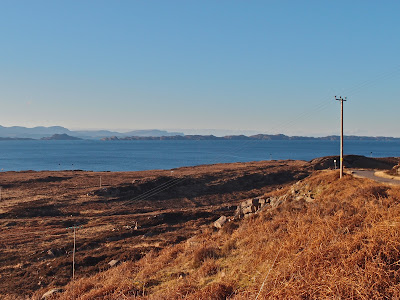 |
| Bla Bheinn from Strath Suardal |
 |
| Bla Bheinn and Garb bheinn from Loch Slappin |
 |
| Rum |
 |
| Last cottage at Suisnish, Rum behind |
 |
| Suisnish forest |
 |
| Red Cuillin from Loch Slappin |
 |
| Wool at Camas Malag beach |
 |
| Beinn Sgriol from Isle Ornsay |
With the prospect of yet another glorious day as the high pressure settled over the north-west of Scotland, we thought about a trip to Raasay, one of the few islands yet to be visited and home of the great poet Sorley MacLean. We met a couple who lived there and were told that there was only one ferry on Sunday and that the hotel and cafes were closed. We should have gone but a relaxed breakfast meant that we were too late for the only ferry so we drove across the bridge to Skye and drove down to Torrin. The Strathaird estate is now owned by the John Muir Trust, previously it had been developed by Ian Anderson of Jethro Tull. It contains the spectacular peaks of Bla Bheinn and Garbh Bheinn but we headed for Loch Slappin to the beach at Camas Malag where I had camped last time I climbed Bla Bheinn. I was tempted to repeat the climb on such a perfect day, my last two outings on Bla Bheinn have been in dire weather, but it can wait.
Our objective was one of the villages, Suisnish, razed to the ground during the Highland clearances. The walk along a good track alongside Loch Slappin allowed us to be mesmerised by the views - Bla Bheinn, Rhum and then the whole Cuillin ridge revealed itself peak by peak. Suisnish was reached and after visiting the ruins of the old shielings, we had a break by the last remaining shepherd's cottage which had been occupied until 1960. It was a superb location as was the site of the old village facing the sea and the sun to the south-west, an aspect that also guaranteed prevailing winds. Over 300 people were evacuated to make way for sheep and boats set sail from Sleat for Australia and Nova Scotia. Many died in transit and Sorley MacLean, a tireless chronicler of injustice and poverty, captures the devastation in his poem Hallaig.
If it doesn't, I'll go to Hallaig,
To the sabbath of the dead,
Down to where each departed
Generation has gathered.
To the sabbath of the dead,
Down to where each departed
Generation has gathered.
Hallaig is where they survive,
All the MacLeans and MacLeads
Who were there in the time of Mac Gille Chaluim:
The dead have been seen alive,
All the MacLeans and MacLeads
Who were there in the time of Mac Gille Chaluim:
The dead have been seen alive,
......
And coming boack from Clachan
And Suisnish, their land of the living,
Still lightsome and unheartbroken,
Their stories only beginning.
And Suisnish, their land of the living,
Still lightsome and unheartbroken,
Their stories only beginning.
There has been a lot of recent housebuilding with new houses vying for views over the fabulous Loch Hourn where Beinn Sgriol and Ladhar Bheinn provide the pillars of a skyline that has few peers, even in this part of the world. The Inner Sound is home of sea eagles and otters making this a wonderful corner of Skye - off the beaten track but only 15 minutes from the Skye Bridge. Some locals told me that the finest short walk was over the Skye Bridge and certainly as we drove over as the evening light faded it seemed that they might be right, numerous locals were promenading over the bridge with that glint of disbelief that views like this inspire.



















































